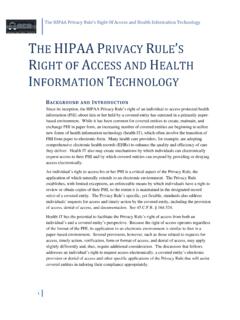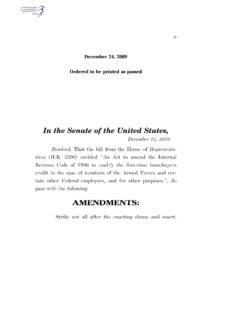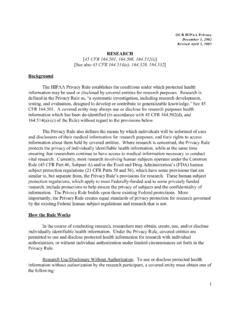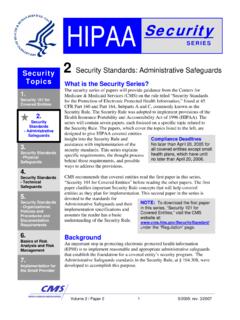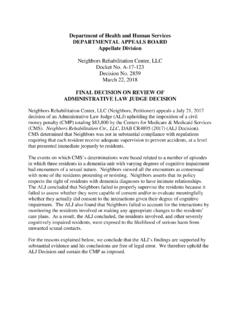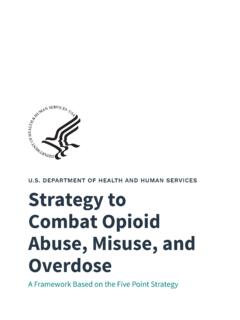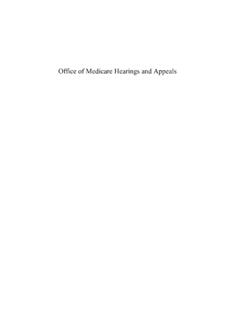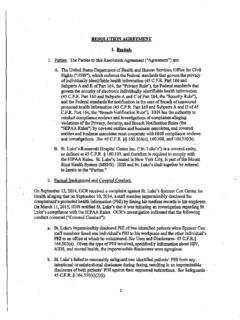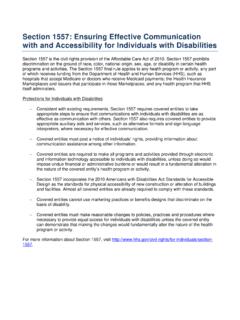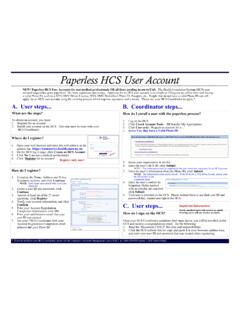Transcription of HIPAA Security Series #4 - Technical Safeguards
1 Security HIPAA Series . Security 4 Security Standards: Technical Safeguards Topics What is the Security Series ? The Security Series of papers will provide guidance from the Centers for 1. Medicare & Medicaid Services (CMS) on the rule titled Security Standards Security 101 for for the Protection of Electronic Protected Health Information, found at 45. Covered Entities CFR Part 160 and Part 164, Subparts A and C, commonly known as the 2. Security Rule. The Security Rule was adopted to implement provisions of the Security Standards Health Insurance Portability and Accountability Act of 1996 ( HIPAA ). The - Administrative Series will contain seven papers, each focused on a specific topic related to Safeguards the Security Rule. The papers, which cover the topics listed to the left, are designed to give HIPAA covered entities 3.
2 Insight into the Security Rule, and Compliance Deadlines Security Standards assistance with implementation of the No later than April 20, 2005 for - Physical all covered entities except small Security standards. This Series explains Safeguards health plans, which had until specific requirements, the thought process behind those requirements, and possible April 20, 2006 to comply. 4. ways to address the provisions. Security Standards - Technical CMS recommends that covered entities read the first paper in this Series , Safeguards Security 101 for Covered Entities before reading the other papers. The first paper clarifies important Security Rule concepts that will help covered entities as they plan for implementation. This fourth paper in the Series is 5. devoted to the standards for Technical Security Standards - NOTE: To download the first Organizational, Safeguards and their implementation paper in this Series , Security Policies and specifications and assumes the reader has Procedures, and 101 for Covered Entities, visit a basic understanding of the Security the CMS website at: Documentation Requirements Rule.
3 Under the Regulation & Guidance page. 6. Basics of Risk Background Analysis and Risk Management Technical Safeguards are becoming increasingly more important due to technology advancements in the health care industry. As technology 7. improves, new Security challenges emerge. Healthcare organizations are faced Implementation for with the challenge of protecting electronic protected health information the Small Provider (EPHI), such as electronic health records, from various internal and external risks. To reduce risks to EPHI, covered entities must implement Technical Safeguards . Implementation of the Technical Safeguards standards Volume 2 / Paper 4 1 5/2005: rev. 3/2007. 4 Security Standards: Technical Safeguards represent good business practices for technology and associated Technical HIPAA Security . STANDARDS.
4 Policies and procedures within a covered entity. It is important, and therefore required by the Security Rule, for a covered entity to comply with Security Standards: the Technical Safeguard standards and certain implementation General Rules specifications; a covered entity may use any Security measures that allow it ADMINISTRATIVE to reasonably and appropriately do so. Safeguards . - Security Management The objectives of this paper are to: Process - Assigned Security - Responsibility Workforce Security Review each Technical Safeguards standard and implementation - Information Access specification listed in the Security Rule. Management - Security Awareness and Training Discuss the purpose for each standard. - Security Incident - Procedures Contingency Plan Provide sample questions that covered entities may want to - Evaluation consider when implementing the Technical Safeguards .
5 - Business Associate Contracts and Other Arrangements Sample questions provided in this paper, and other HIPAA Security Series papers, are for consideration only and are not required for implementation. PHYSICAL. Safeguards . The purpose of the sample questions is to promote review of a covered - Facility Access entity's environment in relation to the requirements of the Security Rule. Controls The sample questions are not HHS interpretations of the requirements of the - Workstation Use - Workstation Security Security Rule. - Device and Media Controls Technical What are Technical Safeguards ? Safeguards . - Access Control The Security Rule defines Technical Safeguards in as the - Audit Controls technology and the policy and procedures for its use that protect electronic - Integrity protected health information and control access to it.
6 - Person or Entity Authentication - Transmission Security As outlined in previous papers in this Series , the Security Rule is based on ORGANIZATIONAL. the fundamental concepts of flexibility, scalability and technology REQUIREMENTS neutrality. Therefore, no specific requirements for types of technology to - Business Associate implement are identified. The Rule allows a covered entity to use any Contracts & Other Arrangements Security measures that allows it reasonably and appropriately to implement - Requirements for the standards and implementation specifications. A covered entity must Group Health Plans determine which Security measures and specific technologies are reasonable POLICIES and and appropriate for implementation in its organization. PROCEDURES and DOCUMENTATION 45 CFR (b), the Security Standards: General Rules, Flexibility of REQUIREMENTS.
7 Approach, provides key guidance for focusing compliance decisions, including factors a covered entity must consider when selecting Security Volume 2 / Paper 4 2 5/2005: rev. 3/2007. 4 Security Standards: Technical Safeguards measures such as technology solutions. In addition, the NOTE: For more information results of the required risk analysis and risk management about Risk Analysis and Risk processes at (a)(1)(ii)(A) & (B) will also assist the Management, see paper 6 in entity to make informed decisions regarding which Security this Series , Basics of Risk measures to implement. Analysis and Risk Management.. The Security Rule does not require specific technology solutions. In this paper, some Security measures and Technical solutions are provided as examples to illustrate the standards and implementation specifications.
8 These are only examples. There are many Technical Security tools, products, and solutions that a covered entity may select. Determining which Security measure to implement is a decision that covered entities must make based on what is reasonable and appropriate for their specific organization, given their own unique characteristics, as specified in (b) the Security Standards: General Rules, Flexibility of Approach. Some solutions may be costly, especially for smaller covered entities. While cost is one factor a covered entity may NOTE: A covered entity must establish a balance between consider when deciding on the implementation of a particular the identifiable risks and Security measure, it is not the only factor. The Security Rule vulnerabilities to EPHI, the cost is clear that reasonable and appropriate Security measures of various protective measures must be implemented, see 45 CFR (b), and that the and the size, complexity, and General Requirements of (a) must be met.
9 Capabilities of the entity, as provided in (b)(2). STANDARD. (a)(1) Access Control The Security Rule defines access in as the ability or the means necessary to read, write, modify, or communicate data/information or otherwise use any system resource. (This definition applies to access as used in this subpart, not as used in subpart E of this part [the HIPAA Privacy Rule]). Access controls provide users with rights and/or privileges to access and perform functions using information systems, applications, programs, or files. Access controls should enable authorized users to access the minimum necessary information needed to perform job functions. Rights and/or privileges should be granted to authorized users based on a set of access rules that the covered entity is required to implement as part of (a)(4), the Information Access NOTE: For more information Management standard under the Administrative Safeguards on Information Access section of the Rule.
10 Management, see paper 2 in this Series , Security Standards The Access Control standard requires a covered entity to: Administrative Safeguards .. Volume 2 / Paper 4 3 5/2005: rev. 3/2007. 4 Security Standards: Technical Safeguards Implement Technical policies and procedures for electronic information systems that maintain electronic protected health information to allow access only to those persons or software programs that have been granted access rights as specified in (a)(4)[Information Access Management].. A covered entity can comply with this standard through a combination of access control methods and Technical controls. There are a variety of access control methods and Technical controls that are available within most information systems. The Security Rule does not identify a specific type of access control method or technology to implement.
